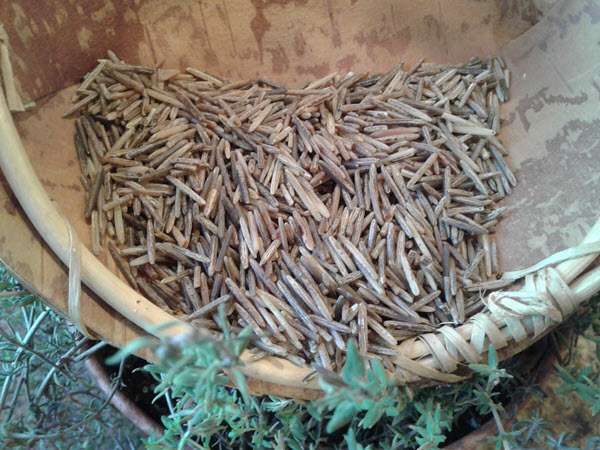
| <- Back to main page |

|
Shake, shss, shss, shake, shhss, shss. Manoomin whispers against the sides of a birch bark makak, stitched with strips of black spruce roots. Not actually rice, but the fruit of a tall green grass that grows on the lakes of northern Minnesota. Grains the shape of a tundra spruce’s shrunken needles; the color of the gray and brown underside of a raccoon. Each like a piece of faded amber, hard and smooth; they snap in half from the pressure of a thumbnail pressed against a grain bridging the gap between the tips of index and middle fingers.

Manoomin contrasts with the pellets of black paddy rice in Uncle Ben’s blend boxes. That is an agribusiness item, altered for commercial production, grown in petro-chemical sloughs in California, harvested by Korean-built combines. Look at it—indistinguishable from mouse turds.
A joke from my Anishinabe friend, Pat Bellanger: “How you cook paddy rice: Put paddy rice and water in a pot with a stone and boil. When the stone is soft, the rice is almost done.”
Scoop a half pound of manoomin from the burlap sack with two hands and bring it to your face. Close your eyes, slightly part your lips and draw in a breath of dusty scents—almost like grandma’s hay barn in midwinter. Pop in a few and roll them on your tongue, breathing slowly so the aroma touches the back of the palate and rises through your nose. Do you smell the verges of Mille Lacs? Taste the terroir of Fond Du Lac? A hint of smoke, like a faint lapsang suchong? Experts claim they can distinguish lake by lake, texture by texture, smell by smell.
The Anishinabe and the Dakota before them used birch canoes; their teams poled to the shallows where the forward harvester used two sticks, one to bend the stalks over the cane, the other to beat the harvest-ready heads so they’d fall to fill the canoe. The canoes rode lower and lower on the water as they filled with manoomin to feed families and visitors through the winter. Some do it this way still, though canoes are likely formed of aluminum or plastic.
Manoomin when harvested is covered with husks and must be dried and winnowed. In the past, large cast iron were leaned against outdoor wood fires and the rice is parched—heated and stirred and stirred to loosen the husks and turn the green grains to brown and gray. When ready the manoomin was moved into birch winnowing baskets and tossed and caught, tossed and caught, tossed and caught. The autumn northwest wind wafts away the husks, and the grains fall back into the wide and shallow baskets. Shake, shsssss, shake shssssss…
Pat tells me that when her family had a big harvest, they jacked a pickup’s rear end off the ground and ran a conveyor belt from the idling rear wheel. It ran to a contraption that attached to and shook a huge pan the size of a hood of a ’62 Pontiac. The rice parched in the sheet metal pan atop a wide fire field of aspen wood. Manoomin picked up distinctive wood smoke flavors as the family joked and argued and reminisced while pushing the mounds around with canoe paddles.
Anishinabe food and environmental activists have campaigned to stop the University of Minnesota and agribusiness from analyzing manoomin’s genetic profile. One origin of this resistance is the spiritual connections that run between Turtle Island (this continent), the water, the manoomin and the indigenous and other appreciative people of this land. Just one mystery that need not be subjected to science.
More immediate is a real threat that a multinational’s pipeline oil spill or mining discharge will destroy the rice beds. And the concern that Cargill or Sandoz will turn this food from an object of respect and worship into a patented commodity. Or that Monsanto (the home of Agent Orange) will develop a genetically modified version that, like much corn today, will grow prodigiously, harvest easily but be bred sterile, crowding out manoomin from lakes and markets.
So… shake, shss, shss, shake, shhss, shss. The rhythm of a fancy dance. Pop in a few and roll them on your tongue, breathing slowly so the aroma touches the back of the palate and rises through your nose….
Real manoomin is available from my teacher and friend’s family at Northland Visions, 861 East Hennepin Ave. in Minneapolis. Northland sells art, clothing, beads, pottery, music, and other authentic products.